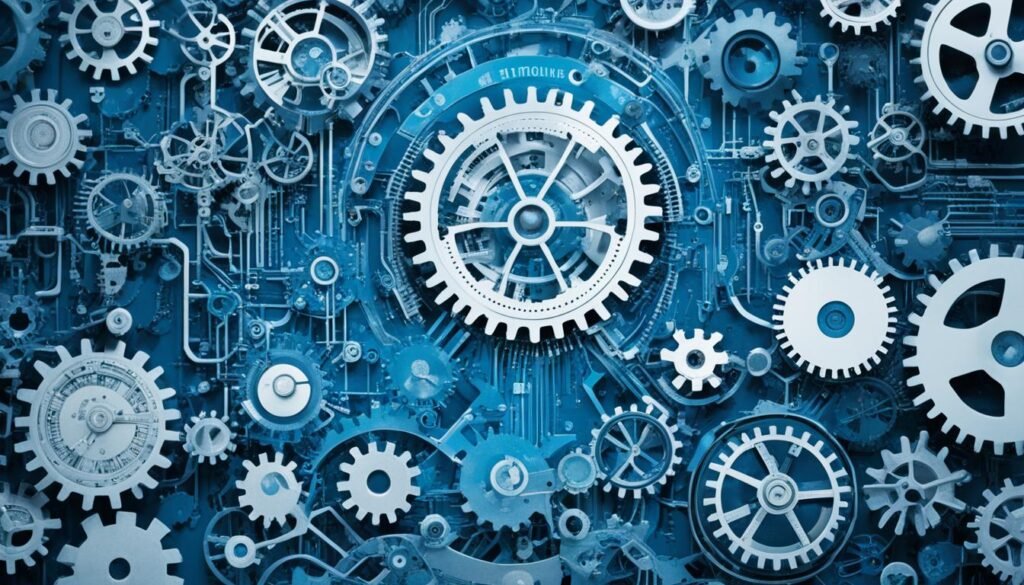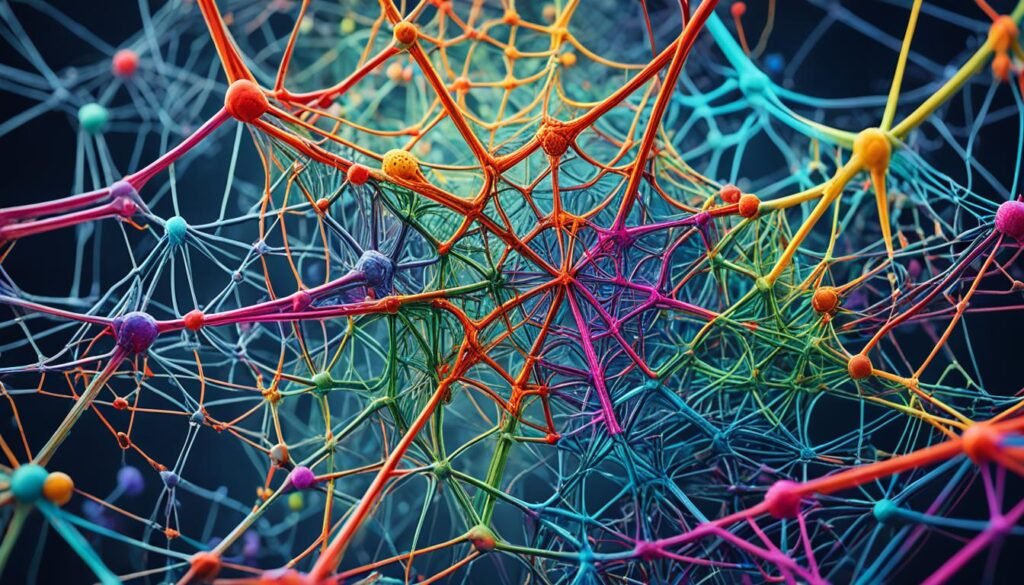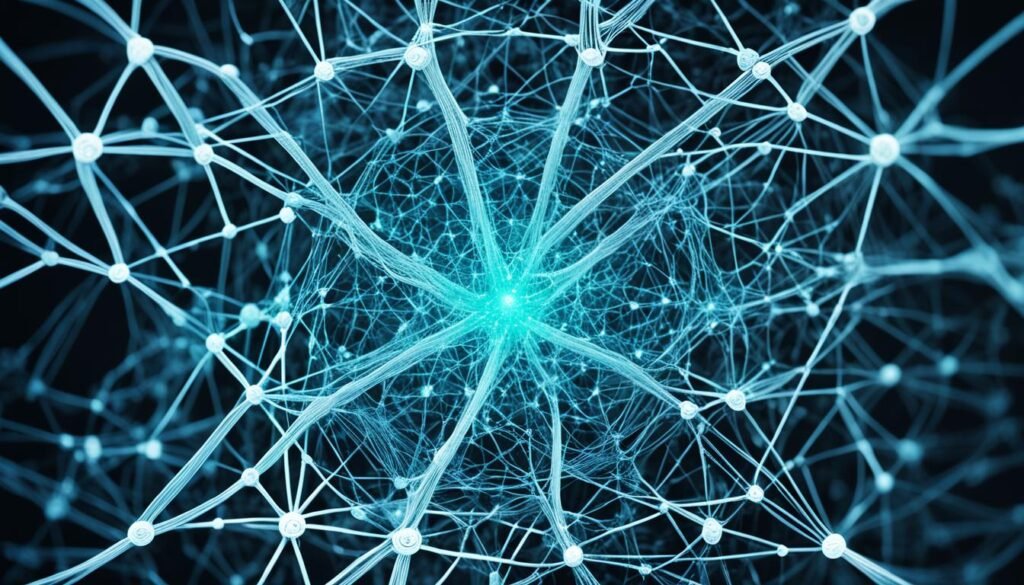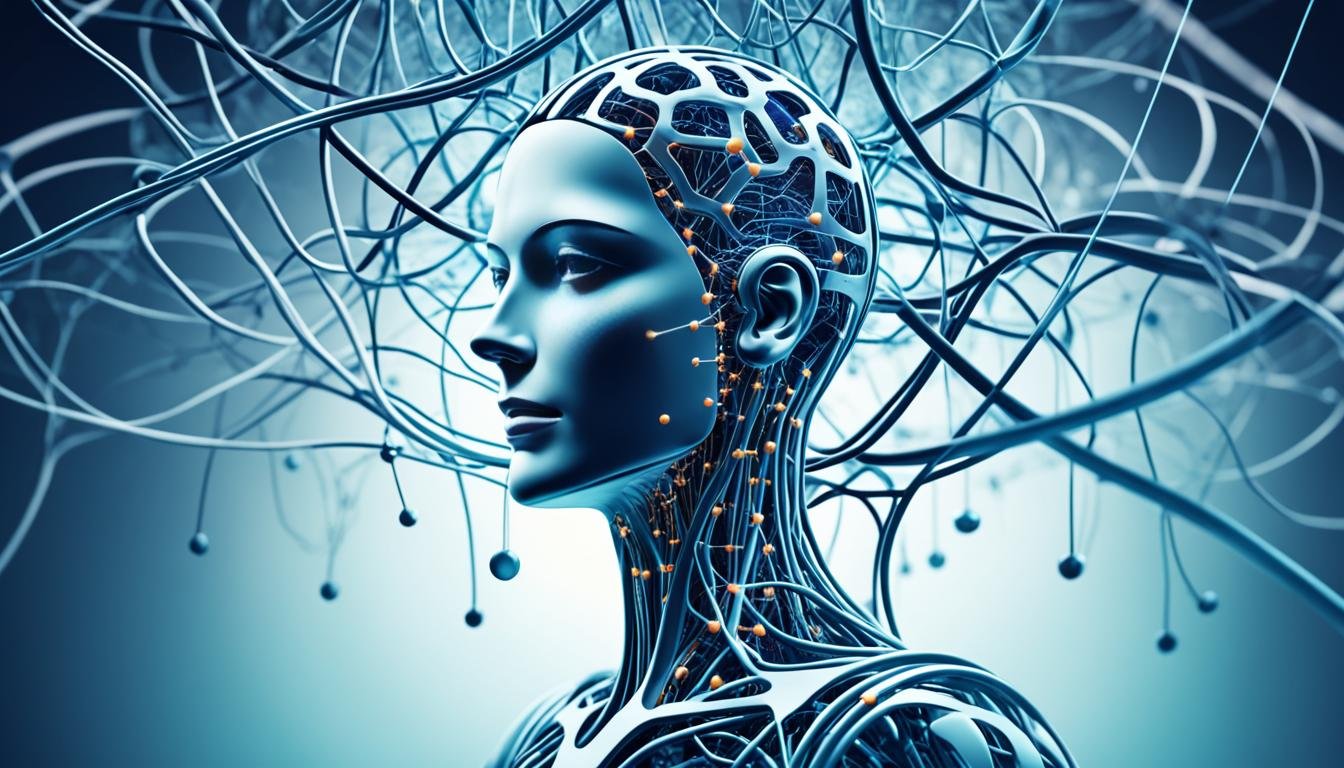Ever thought AI was more like magic than science? You’re not the only one. With AI’s fast growth, from self-driving cars to chatbots like ChatGPT, it seems like a mysterious force. But, AI is actually a complex science, and “How AI Works: From Sorcery to Science” will clear up the mystery.
This book, by an expert with over 60 AI books, is a top pick for learning about machine learning and AI. It explains the basics of machine learning clearly and simply. You’ll learn about old systems and the latest neural networks and language models that are changing AI today.
Whether you know nothing or a lot about AI, “How AI Works” will guide you through its history. You’ll see how AI went from being seen as sorcery to a powerful science. You’ll discover key advancements, like the 2012 deep learning revolution and how models like OpenAI’s ChatGPT changed the game.
Key Takeaways
- Artificial intelligence is not magic, but a highly sophisticated field of science.
- The book “How AI Works: From Sorcery to Science” provides a clear and accessible explanation of the core fundamentals of machine learning.
- The book covers a range of AI systems, from legacy methodologies to cutting-edge neural networks and large language models.
- OpenAI’s ChatGPT is highlighted as a significant advancement in AI understanding, showcasing the power of large language models.
- The book is aimed at a broad audience, from novices to those with a substantial grasp of the subject matter.
Demystifying the AI Revolution
The link between artificial intelligence (AI), machine learning, and deep learning is complex and intriguing. Machine learning lets machines learn from data without needing to be programmed. Deep learning, a part of machine learning, copies how the human brain works. It has led to big steps forward in things like recognizing images and making self-driving cars.
The AI revolution is happening now because of years of work in symbolic AI. That work didn’t meet expectations, but it set the stage for neural networks. These models, based on the human brain, are great at handling lots of data. They’ve led to huge achievements in AI.
The Relationship Between AI, Machine Learning, and Deep Learning
AI is all about making systems that can do things that need human smarts, like learning and solving problems. Machine learning is a part of AI that helps algorithms get better on their own, without being told how.
Deep learning is a special kind of machine learning. It uses artificial neural networks to work with data like the human brain does. This has led to big improvements in things like understanding language, recognizing images, and making speech.
| Concept | Definition | Examples |
|---|---|---|
| Artificial Intelligence (AI) | The development of systems capable of performing tasks that typically require human intelligence. | Virtual assistants, self-driving cars, and game-playing algorithms. |
| Machine Learning | A subset of AI that focuses on enabling algorithms to automatically improve their performance through experience, without being explicitly programmed. | Predictive analytics, recommendation systems, and fraud detection. |
| Deep Learning | A specialized form of machine learning that utilizes artificial neural networks to process and analyze data in a way that mimics the human brain. | Image recognition, natural language processing, and speech generation. |
The AI revolution is still growing, and how these concepts work together will shape the future of AI. This will lead to more advanced AI systems that change industries and improve our lives.
A Brief History of Artificial Intelligence
The story of artificial intelligence (AI) is fascinating, blending into human progress. It started with early ideas and has grown to today’s advanced tech. The journey of artificial intelligence fundamentals has seen both successes and hurdles.
In the 1950s, pioneers like Alan Turing, John McCarthy, and Marvin Minsky set the stage for AI. Their work led to the first AI computer program, Logic Theorist, in 1956.
The 1960s and 1970s brought a surge in AI interest. Researchers explored how far machines could go. They made ELIZA, the first chatbot, and started the Fifth Generation Computing Project in Japan, showing AI’s potential.
But, AI faced challenges too, with two “AI winters” from 1974-1980 and 1987-1993. These times of less funding and research slowed progress. Yet, they led to new neural network discoveries and breakthroughs in the 2000s.
“The history of artificial intelligence reflects scientific progress, engineering failures, and triumphs, intertwined with humanity’s quest to understand the human mind and consciousness.”
Recently, AI has seen a big leap forward. Advances in computer hardware, better algorithms, and more data have pushed AI to new levels. Events like Deep Blue’s victory over chess champion Gary Kasparov and IBM’s Watson winning on Jeopardy caught everyone’s attention.
Now, AI is everywhere, from smart speakers to self-driving cars, and language models like ChatGPT. These technologies blend into our lives easily. The debate on whether machines can truly think and be conscious continues, engaging scientists and the public.

The story of AI shows our endless creativity and the drive to understand the mind. From the first ideas to today’s advanced tech, AI’s history is a mix of science, technology, and our wish to explore the unknown.
The Rise and Fall of Symbolic AI
In the early days of artificial intelligence (AI), symbolic AI was the main focus. From the mid-1950s to the mid-1990s, it aimed to model intelligent behavior with formal logic and knowledge systems. This approach led AI development.
By the 1960s, symbolic AI had made great strides. Researchers could simulate intelligent actions in games, math, and proving theorems. This led to a boom in AI research from 1969 to 1986. Then, a period called the second AI Winter followed, lasting from 1988 to 2011.
How Decades of Work in Symbolic AI Paved the Way for Neural Networks
Even though symbolic AI rose and fell, its research set the stage for neural networks. Techniques like heuristic search and the A* algorithm prepared the ground for today’s machine learning. These methods are now key to neural networks.
As symbolic AI’s limits became clear, researchers turned to neuro-symbolic AI. This combines statistical AI with symbolic knowledge and reasoning. This shift has brought a new focus on blending data processing with symbolic thinking. Researchers like Henry Kautz, Francesca Rossi, and Bart Selman are leading this effort.
| Key Milestones in the Rise and Fall of Symbolic AI | Timeline |
|---|---|
| Symbolic AI was the dominant paradigm of AI research | Mid-1950s to mid-1990s |
| Early boom in AI research with the rise of expert systems | 1969 to 1986 |
| The second AI Winter | 1988 to 2011 |
| Neural networks reemerged strongly, leading to the current era of deep learning success | 2012 onward |
The shift from symbolic AI to neural networks marks a key moment in AI history. As we move forward in AI, the lessons from this evolution will guide us. They will shape the future of this fast-growing field.
Neural Networks Explained
Neural networks are key in artificial intelligence today. They mimic the human brain and change how we handle data and create smart systems.
Understanding the Building Blocks of Modern AI
Neural networks have a simple yet strong idea – nodes, or “neurons,” that connect to learn and decide. These neurons take in information, do math, and send out signals, just like our brain cells. By linking these neurons in layers, neural networks can handle tough tasks, from understanding language to seeing images.
What makes neural networks special is how they learn and adapt with backpropagation. This method helps the network adjust its models and improve its performance over time. This leads to better and more precise results.
| Key Characteristics of Neural Networks | Applications |
|---|---|
|
|
As artificial intelligence grows, neural networks stay ahead. They are the base for many smart systems and new tech that change our digital world.
Training Neural Networks
Learning how to train machine learning algorithms, especially neural networks, is key to modern artificial intelligence. By adjusting the parameters and fine-tuning the data processing, you can make these machine learning algorithms work better. This leads to big steps forward in many areas.
At the core, it’s about making the neural network better through many cycles of improvement. You tweak the computational models to do better at tasks like understanding language, recognizing images, or predicting outcomes. The way the network’s structure and data processing techniques work together is what makes training neural networks successful.
Training neural networks relies on the idea of gradient descent. This method helps the network find the best settings by adjusting the error slopes. With techniques like backpropagation, the network gets better over time.
Choosing and preparing good training data is also key. High-quality, diverse data helps the network learn to apply what it knows in real situations, not just remember specific examples. This focus on data quality is crucial for machine learning algorithms and computational models.
Exploring neural network training reveals many specialized techniques and methods. Each one tackles different challenges and boosts performance. The field is always changing, full of new ideas and discoveries.
| Feature | Description | Benefit |
|---|---|---|
| Gradient Descent | Iterative optimization of network parameters to minimize error | Enables neural networks to learn and improve performance |
| Backpropagation | Efficient algorithm for computing gradients in neural networks | Facilitates effective training of complex neural network architectures |
| Regularization | Techniques to prevent overfitting and improve generalization | Enhances the robustness and real-world performance of neural networks |
| Hyperparameter Tuning | Optimization of network hyperparameters for optimal performance | Unlocks the full potential of neural network models |
By learning how to train neural networks, you can unlock the power of machine learning algorithms and computational models. This leads to big advances in artificial intelligence and its uses in the real world.
The Power of Simple Math
At the heart of modern artificial intelligence (AI) and machine learning (ML), a surprising truth stands out. These technologies’ power comes from the simple math of multiplication. AI might seem complex, but it’s built on simple, refined math principles. These have been improved over decades of research and development.
The secret to neural networks, key to many AI systems, is learning from data. They use data processing techniques and computational models. Inspired by the human brain, these networks process information, spot patterns, and predict outcomes. Multiplication is crucial here, adjusting connections between nodes to help the network learn and adapt.

AI has shown it can beat human experts in many areas, from finance to medicine. This success comes from its strong math and modeling. AI systems analyze huge data, find complex patterns, and make precise decisions thanks to computational models.
Researchers and engineers are dedicated to improving neural networks and machine learning. Their work has opened new doors, changing our world in big ways.
Why Modern AI Boils Down to Multiplication
The essence of artificial intelligence and machine learning is learning from data and predicting accurately. This is powered by simple math, like multiplication. It helps AI systems tweak their connections and improve their performance.
Math is key in AI’s success, from predicting outcomes to recognizing images. By using advanced computational models and data processing techniques, AI can quickly sift through lots of info. It spots patterns and makes decisions that often beat human experts.
Advances in neural networks and machine learning show the hard work of researchers and engineers. They keep pushing AI’s limits. As they refine AI’s math, we’ll see more amazing breakthroughs that will change our world.
how ai works from sorcery to science
Artificial intelligence (AI) has moved from being seen as sorcery to being a science. It’s now a key part of our lives, thanks to its history and impact. We’ll look at how AI has changed, focusing on its core ideas, algorithms, and structures.
Machine learning is at the core of AI. It’s about making models that can learn and get better from data. AI has changed a lot, from the old symbolic AI to today’s neural networks and deep learning. Now, AI can handle lots of data, spot patterns, and make smart choices, all like how we think.
AI’s growth has been fueled by new tech in data handling, models, and system design. It uses math and algorithms to solve tough problems in many areas, like health and finance. This journey has had ups and downs, but the drive to understand intelligence has led to big advances.
Looking into AI, we’ll see what makes it tick, like cognitive computing and neural networks. This will show you how powerful AI is and how it can change our world, step by step.
“The true sign of intelligence is not knowledge but imagination.” – Albert Einstein
AI’s story is one of big changes, moving from sorcery to science. By grasping its core ideas and tech, we can explore new possibilities. This will help us use AI to make a better future for everyone.
The Emergence of Large Language Models
ChatGPT, Bard, and the Future of AI
The world of artificial intelligence (AI) has changed a lot with the arrival of large language models like ChatGPT and Bard. These systems use neural networks and advanced data processing to push the limits of AI. They show us what’s possible with computational models and smart systems.
ChatGPT, made by OpenAI, has become very popular. It can talk like a human, answer questions, and even create new content. Bard, from Google, is another big name in this new AI wave. It’s set to change how we use AI in the ai development lifecycle.
These models are more than just cool tech. They change how we use and think about AI. By using neural networks explained and data processing techniques, they open new doors in computational models and intelligent systems architecture.
“The emergence of large language models like ChatGPT and Bard has ushered in a new era of AI, one where the boundaries between human and machine intelligence are becoming increasingly blurred.”
The rise of AI brings both good and bad. These models can talk like us, create new content, and solve many problems. This could change many industries and how we solve problems.

But with big power comes big responsibility. We need to make sure these models are used right. As AI grows, we must think about bias, privacy, and misuse. The ai development lifecycle needs careful thought.
The future looks bright with ChatGPT, Bard, and others. With careful thought and responsible innovation, we can use these models for good. This could lead to a future where AI and humans work together well.
Ethical Considerations in AI Development
Artificial intelligence (AI) is growing fast, and we must think about its ethical sides. Artificial intelligence fundamentals and cognitive computing principles affect us a lot. It’s key to make sure the AI development lifecycle follows ethical AI practices.
One big worry is bias in AI. AI learns from data that might have biases, leading to unfair results in things like jobs, loans, and justice. People making AI must watch out for and fix these biases. This makes sure AI makes fair and just decisions.
AI also changes jobs. As AI takes over more jobs, we need to help workers get new skills. This means working together between governments, companies, and schools to make a future that includes everyone.
“The development of full artificial intelligence could spell the end of the human race. … It would take off on its own, and re-design itself at an ever-increasing rate. Humans, who are limited by slow biological evolution, couldn’t compete, and would be superseded.”
– Stephen Hawking
Privacy and keeping data safe are big issues with AI. AI systems handle a lot of personal data. We need strong rules to protect our privacy and stop misuse of our info.
Dealing with AI’s ethics means looking at many sides. We need to keep improving technology and protecting human values and society. By using ethical AI practices, we can make AI better for us. This way, we avoid risks and bad effects.
AI in Action: Real-World Applications
Artificial intelligence (AI) has moved from science fiction to real life, changing industries and our daily lives. It’s used in self-driving cars and medical imaging, solving complex problems. Let’s look at how artificial intelligence fundamentals and intelligent systems architecture are making a difference.
Transforming Transportation with Self-Driving Cars
AI is big in making self-driving cars. Computational models and data processing techniques help these cars drive safely and efficiently. They use sensors to understand the road and make quick decisions.
Revolutionizing Healthcare with AI-Powered Diagnostics
The healthcare industry has changed thanks to AI development lifecycle. AI helps analyze medical scans fast and accurately. This leads to better diagnoses and faster responses, helping patients.
| Industry | AI Application | Impact |
|---|---|---|
| Finance | Fraud detection, risk management, algorithmic trading | Improved fraud detection, optimized trading strategies, enhanced risk management |
| Manufacturing | Predictive maintenance, process optimization, quality control | Reduced downtime, increased efficiency, improved product quality |
| Agriculture | Precision farming, crop yield prediction, pest control | Increased crop yields, reduced water usage, enhanced pest management |
Artificial intelligence fundamentals, data processing techniques, and intelligent systems architecture are changing many industries. As AI grows, we’ll see more amazing changes in the future.

The Future of Artificial Intelligence
Artificial intelligence is opening up exciting new possibilities. The fast growth in machine learning algorithms, neural networks explained, and computational models is leading to big changes. These changes will shape our future.
Large language models like ChatGPT and Bard are changing the game. They can understand and generate human-like text and solve complex problems. As they get better, they will push the limits of what we can do with artificial intelligence fundamentals.
AI is also getting smarter in understanding the world around us. Researchers are working on making AI systems think more like humans. This could lead to big advances in robotics, decision-making, and scientific discoveries.
| Trend | Impact | Potential Applications |
|---|---|---|
| Explainable AI (XAI) | Enhancing transparency and trustworthiness of AI systems | Healthcare, finance, and regulatory compliance |
| Ethical AI Development | Ensuring AI systems are designed with human values and principles in mind | Mitigating bias, protecting privacy, and promoting social good |
| Quantum Computing for AI | Unlocking new frontiers in computational power and algorithm optimization | Cryptography, drug discovery, and materials science |
The future looks bright for artificial intelligence fundamentals. The progress we’ve made will change how we use technology. By using machine learning algorithms and neural networks explained, we can solve big problems and transform society.
“Understanding and controlling AI technologies is crucial for optimal performance. We need to gain insight into AI to avoid being seduced by its capabilities.”
– Sine Zambach, Assistant Professor at the Department of Digitalization, CBS
Conclusion
We’ve taken a deep dive into the world of artificial intelligence (AI), from its magical beginnings to today’s scientific advancements. You now know how this groundbreaking technology works. You’ve learned about machine learning, neural networks, and the tech behind smart systems.
AI and science are already changing the game, with big wins in fields like space, medicine, and the environment. As cognitive computing gets better, we’ll see even more amazing things. But, we must make sure AI is used right, for the good of all people.
The dream of artificial general intelligence (AGI) is to create AI as smart as us, with the ability to learn and be creative. It might sound like something from a movie, but we’re getting closer thanks to ongoing AI research and better technology. Keep in mind what you’ve learned about AI’s journey from magic to science. Let’s help shape the future of this incredible technology together.
FAQ
What is the relationship between artificial intelligence, machine learning, and deep learning?
Artificial intelligence (AI) uses machines to do tasks that need human smarts. Machine learning is a part of AI that trains algorithms to learn from data. Deep learning is a type of machine learning that uses neural networks to understand and learn from lots of data.
How has the development of artificial intelligence evolved over time?
AI started with early ideas and has grown a lot. The old symbolic AI, which used rules and logic, led to neural networks. These networks are now key to modern AI.
How do neural networks work, and why are they the core of modern AI systems?
Neural networks are the heart of modern AI. They copy the brain’s structure and learn to spot patterns and make choices. Their ability to learn and change makes them vital for AI progress.
What is the process of training neural networks, and how do these techniques contribute to the performance of AI systems?
Training neural networks means adjusting their parts to get the right results. Techniques like backpropagation help improve their performance. This makes the AI systems work better.
How has the emergence of large language models, such as ChatGPT and Bard, shaped the future of artificial intelligence?
Big language models like ChatGPT and Bard have changed AI. They show how AI can understand and generate text, and understand context. This changes the future of AI and its uses in many areas.
What are the ethical considerations surrounding the development and deployment of AI systems?
As AI gets better, we must think about its ethics. We need to make sure AI is used right, with clear rules and respect for values. This is key for AI’s growth and use.
How is AI being applied in the real world, and what are some of the transformative impacts it is having?
AI is used in many areas, like self-driving cars and medical imaging. These uses show AI’s power to innovate and improve our lives.
What are the future possibilities and emerging trends in the field of artificial intelligence?
AI is moving fast, and the future looks exciting. Research is pushing forward machine learning, neural networks, and cognitive computing. These will shape AI’s future and its effects on us.
